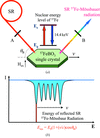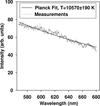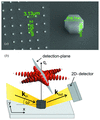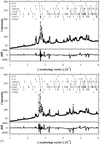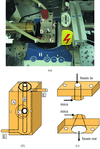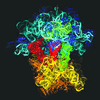issue contents
November 2009 issue
Advances and synergy of high-pressure sciences at synchrotron sources

Cover illustration: The integration of nuclear resonant scattering and X-ray diffraction techniques for high-pressure research at 3-ID-B, APS, which is a typical non-dedicated high-pressure beamline with strong high-pressure research program (see Gao, Chen, Lerche, Alp, Sturhahn, Zhao, Yavas and Li, pages 714-722). Photographs courtesy of Lili Gao and Haozhe Liu.
facility information
high pressure
Free 

Introductory overview to the special issue papers on high-pressure sciences and synchrotron radiation.
The main results of investigations at high pressure using diamond anvil cells obtained at the energy-dispersive X-ray absorption spectrometer of ESRF, ID24, are reviewed.
A brief review of inelastic X-ray scattering with very high energy resolution applied to high-pressure studies on solid and liquid samples is presented.
A recently installed X-ray diffraction facility that is integrated with existing nuclear resonant scattering set-ups at Sector 3 of the Advanced Photon Source at Argonne National Laboratory is introduced. Its applications for measuring the sound velocities of compressed Fe3C are reported.
The principle and development of a new synchrotron radiation 57Fe-Mössbauer spectrometer using a variable-frequency nuclear monochromator are introduced. As a great advantage for high-pressure studies with a diamond anvil cell, the developed spectrometer makes it possible to perform high-pressure 57Fe-Mössbauer spectroscopy in the multimegabar range.
X-ray magnetic spectroscopy under multiple extreme conditions is available at SPring-8 BL39XU. The beamline performance, including the optics and instruments for high pressure, and two topics for high-pressure study are introduced.
A portable laser-heating system for DACs has been developed which can be moved between various analytical facilities, including transfer from in-house to a synchrotron or between synchrotron beamlines. Application of the system is demonstrated in an example of nuclear inelastic scattering measurements of ferropericlase and h.c.p.-Fe0.9Ni0.1 alloy, and X-ray absorption near-edge spectroscopy of majorite at high pressures and temperatures.
A modified Drickamer anvil apparatus has been developed to combine with monochromatic synchrotron radiation for high-pressure X-ray diffraction and radiography in the GSECARS bending-magnet station, 13-BM-D, at the Advanced Photon Source, Argonne, USA.
This contribution reviews and describes state-of-the-art extreme-pressure deformation devices coupled with synchrotron radiation, and corresponding analytical techniques, as well as recent applications for the study of materials plastic properties at extreme conditions.
A system has been developed for stress measurement under high pressure using Kawai-type multi-anvil apparatus combined with synchrotron radiation. The capacity of the system was demonstrated using a KCl sample to 10 GPa.
An experimental system to measure the elastic wave velocities of hot-pressed polycrystalline samples at high pressure and high temperature at SPring-8 is described.
New opportunities for laser heating in diamond anvil cells include time-domain experiments combined with appropriate finite-element calculations, and also improved beam shaping and temperature measurement techniques.
First application of combined high-pressure and high-energy irradiations to investigations of phase transitions.
research papers
An in-vacuum double-phase-plate diffractometer for performing polarization scans combined with resonant X-ray diffraction experiments is presented.
Open  access
access
 access
accessThe use of a hexapod in X-ray diffraction measurements of substrate-supported TIPS-pentacene crystals has been demonstrated to determine the lattice constants and the local orientation of the crystals.
Using a nanofocused X-ray beam, GaAs nanorods grown in a periodic array are identified and individually characterized with the help of coherent diffraction. Rods grown in the centre and at the edge of the array show differences in shape and strain state.
Open  access
access
 access
accessThe improvement of the X-ray beam quality achieved on ID14-4 by the installation of new X-ray optical elements is described.
Correlation between the structural and electronic properties of a single Bi-2212 superconducting whisker was obtained by a combined microdiffraction and resistivity versus T experiment during a three-step annealing process at 363 K. The observed changes, in both properties, are due to an oxygen depletion process taking place at mild temperatures.
The performance and layout of the new microfocus spectroscopy beamline at the Diamond Light Source are described with some examples of early results.
Consolidated mixtures of different Al and Ti powders were heated undergoing in situ analysis by means of high-energy X-ray diffraction and Rietveld analysis. The evolution of the intermetallic phases of the Ti–Al system as well as occurring Ti–H is followed by quantitative phase analysis while much further details are revealed by consideration of the lattice parameters.
The design and first performance of a new low-energy beamline at synchrotron SOLEIL are reported. The energy selection and conservation of the polarization are explained. The beam propagation and conditioning are detailed.
A high-temperature microfurnace has been designed and fabricated for an in situ X-ray diffraction study of phase transformations during the reduction of ilmenite ore.
Structural information on nanocrystalline materials from X-ray total scattering data has been obtained with a massively parallel Mythen II detector using atomic pair distribution function analysis.
Both VUV circular dichroism and fluorescence spectroscopy have been developed at the new 4B8 VUV bending-magnet beamline at BSRF.
Analytical expressions have been derived to determine the errors in the EXAFS analysis by the ratio method owing to the neglect of the higher-order cumulants.
short communications
The development of a thermostatized and agitated sample cell for synchrotron small-angle X-ray scattering measurements of liquid samples (homogeneous or heterogeneous) is presented. The set-up enables the in situ monitoring of fast chemical reactions, such as emulsion polymerization reactions.
computer programs
EDNA is a software framework for developing extensible scientific applications especially in the X-ray experiments field. This article describes the framework as well as a prototype application designed for macromolecular crystallography experiments.
current events
Free 



 journal menu
journal menu























